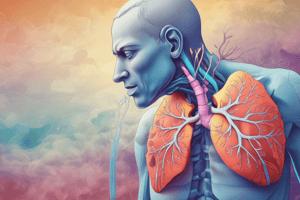Podcast
Questions and Answers
Which of the following conditions is primarily characterized by chronic obstruction of airflow from the lungs?
Which of the following conditions is primarily characterized by chronic obstruction of airflow from the lungs?
- COPD (correct)
- Tuberculosis
- Asthma
- Pneumonia
Antihistamines can help relieve nasal congestion effectively.
Antihistamines can help relieve nasal congestion effectively.
False (B)
What medication promotes vasoconstriction of vessels in the nose?
What medication promotes vasoconstriction of vessels in the nose?
Decongestant
The medication pseudoephedrine is classified as a __________.
The medication pseudoephedrine is classified as a __________.
Match the following medications with their primary side effects or teaching points:
Match the following medications with their primary side effects or teaching points:
What is the maximum flow rate for a high flow nasal cannula?
What is the maximum flow rate for a high flow nasal cannula?
A mask should fit loosely during inhalation.
A mask should fit loosely during inhalation.
What advanced interventions may be needed for a patient with breathing difficulties?
What advanced interventions may be needed for a patient with breathing difficulties?
High flow nasal cannula blends O2 with __________ air.
High flow nasal cannula blends O2 with __________ air.
Match the following interventions with their descriptions:
Match the following interventions with their descriptions:
What does FIO2 represent in the context of oxygen therapy?
What does FIO2 represent in the context of oxygen therapy?
Patients should be monitored closely when using oxygen therapy.
Patients should be monitored closely when using oxygen therapy.
High flow nasal cannula can generate FIO2 up to __________ at a flow rate of up to 60 L/min.
High flow nasal cannula can generate FIO2 up to __________ at a flow rate of up to 60 L/min.
What is the primary benefit of the humidifier described?
What is the primary benefit of the humidifier described?
The humidifier is capable of providing only 50% body humidity.
The humidifier is capable of providing only 50% body humidity.
What type of environment is created by an active humidifier?
What type of environment is created by an active humidifier?
An active humidifier is capable of providing __________ body humidity.
An active humidifier is capable of providing __________ body humidity.
Match the following terms related to humidifiers with their descriptions:
Match the following terms related to humidifiers with their descriptions:
What is the primary cause of Chronic Obstructive Pulmonary Disease (COPD)?
What is the primary cause of Chronic Obstructive Pulmonary Disease (COPD)?
Asthma is characterized by irreversible airway obstruction.
Asthma is characterized by irreversible airway obstruction.
What is one of the clinical manifestations of bacterial pharyngitis?
What is one of the clinical manifestations of bacterial pharyngitis?
The main pathophysiologic process in asthma is persistent but variable _______ of the airways.
The main pathophysiologic process in asthma is persistent but variable _______ of the airways.
Match the following types of pharyngitis with their characteristics:
Match the following types of pharyngitis with their characteristics:
Which antibiotic is NOT typically used for bacterial pharyngitis?
Which antibiotic is NOT typically used for bacterial pharyngitis?
Topical decongestants can be used for more than 5 days without risk.
Topical decongestants can be used for more than 5 days without risk.
What type of lung cancer is commonly associated with COPD?
What type of lung cancer is commonly associated with COPD?
The absence of a cough is a characteristic feature of _______ pharyngitis.
The absence of a cough is a characteristic feature of _______ pharyngitis.
Which of the following is a common assessment finding in chronic bronchitis?
Which of the following is a common assessment finding in chronic bronchitis?
Cor Pulmonale refers to left-sided heart failure due to pulmonary hypertension.
Cor Pulmonale refers to left-sided heart failure due to pulmonary hypertension.
What is a common symptom of asthma during an attack?
What is a common symptom of asthma during an attack?
Secondary infections may require the use of _______.
Secondary infections may require the use of _______.
Match the following diseases with their common treatment approaches:
Match the following diseases with their common treatment approaches:
What is a key nursing care tip for patients with bacterial pharyngitis?
What is a key nursing care tip for patients with bacterial pharyngitis?
What is the most common symptom of chronic cor pulmonale?
What is the most common symptom of chronic cor pulmonale?
All patients with COPD develop cor pulmonale.
All patients with COPD develop cor pulmonale.
Name two physical signs associated with chronic cor pulmonale.
Name two physical signs associated with chronic cor pulmonale.
O2 therapy is linked to improved __________ of COPD patients.
O2 therapy is linked to improved __________ of COPD patients.
Match the following oxygen delivery devices with their descriptions:
Match the following oxygen delivery devices with their descriptions:
Which oxygen delivery device is most commonly used for patients who can tolerate low flow?
Which oxygen delivery device is most commonly used for patients who can tolerate low flow?
The partial and non-rebreather mask is suitable for long-term therapy.
The partial and non-rebreather mask is suitable for long-term therapy.
What flow rate does a simple face mask typically provide?
What flow rate does a simple face mask typically provide?
Oxygen therapy must be prescribed as it is considered a __________.
Oxygen therapy must be prescribed as it is considered a __________.
What should be assessed when using a nasal cannula?
What should be assessed when using a nasal cannula?
Higher oxygen concentrations can lead to CO2 buildup in the blood.
Higher oxygen concentrations can lead to CO2 buildup in the blood.
What flow rate ensures the reservoir bag in a partial non-rebreather is inflated?
What flow rate ensures the reservoir bag in a partial non-rebreather is inflated?
Which symptom is NOT commonly associated with cor pulmonale?
Which symptom is NOT commonly associated with cor pulmonale?
Oxygen therapy increases the partial pressure of O2 in __________ air.
Oxygen therapy increases the partial pressure of O2 in __________ air.
Flashcards are hidden until you start studying
Study Notes
Altered Respiratory Function
- Common respiratory conditions: COPD, Asthma, Emphysema, Tuberculosis, Pneumonia, Sinusitis, Upper Respiratory Infections (URI).
Anatomy and Physiology
- Upper and lower respiratory tracts are essential for gas exchange and airflow regulation.
Upper Respiratory Airway
- Critical for filtering, warming, and humidifying inhaled air.
- Includes the nasal cavity, pharynx, and larynx.
Lower Respiratory Airway
- Comprises the trachea, bronchi, and bronchioles leading to alveoli for gas exchange.
Etiology (Causes)
- Infection (viral/bacterial), allergens, environmental irritants, and lifestyle factors contribute to respiratory diseases.
Medications
- Antihistamines: Reduce acute symptoms like itching and nasal secretions; do not alleviate congestion.
- Decongestants: Induce vasoconstriction to relieve nasal congestion; can raise blood pressure and heart rate.
Influenza
- Seasonal viral infection causing fever, cough, sore throat, and body aches.
Sinusitis
- Inflammation of sinus cavities leading to nasal obstruction, facial pain, and purulent nasal discharge.
Pharyngitis
- Bacterial causes include Group A Streptococcus associated with fever and swollen lymph nodes.
- Viral causes result in symptoms like red pharynx and clear nasal discharge.
Lower Respiratory Problems
- Affected by infections (pneumonia, tuberculosis), chronic conditions (COPD), and obstructive diseases (asthma).
Tuberculosis
- Contagious bacterial infection primarily affecting the lungs, characterized by persistent cough and weight loss.
Obstructive Pulmonary Disease (COPD and Asthma)
- Asthma: Chronic inflammatory disorder of the airways causing wheezing, breathlessness, and reversible airflow obstruction.
- COPD: Primarily caused by cigarette smoking, leading to chronic bronchitis and emphysema.
COPD Complications
- Polycythemia Vera: Increased hemoglobin due to chronic hypoxia.
- Cor Pulmonale: Right heart failure from pulmonary hypertension; significant symptom includes dyspnea.
Oxygen Therapy
- O2 therapy is critical for treating COPD and hypoxemia; it enhances blood oxygen levels.
Flow Delivery Methods for Oxygen
- Low Flow: Nasal cannula and simple face mask; safe and effective for patients with mild to moderate needs.
- High Flow: Nasal cannula and non-rebreather masks; capable of delivering a higher concentration of O2 for critically ill patients.
Nursing Interventions
- Monitor patient responses to oxygen therapy, ensuring equipment fits well and is functioning correctly.
- Provide adequate humidification to prevent drying of airways, especially in higher flow scenarios.
Asthma Risk Factors
- Allergens, pollutants, respiratory infections, and genetic predisposition can exacerbate symptoms.
Assessment and Diagnostics
- Assess lung function through spirometry and symptom history; chest X-rays may also be utilized for diagnosis.
COPD Interventions
- Focus on smoking cessation, bronchodilator therapy, and pulmonary rehabilitation programs.
Studying That Suits You
Use AI to generate personalized quizzes and flashcards to suit your learning preferences.




